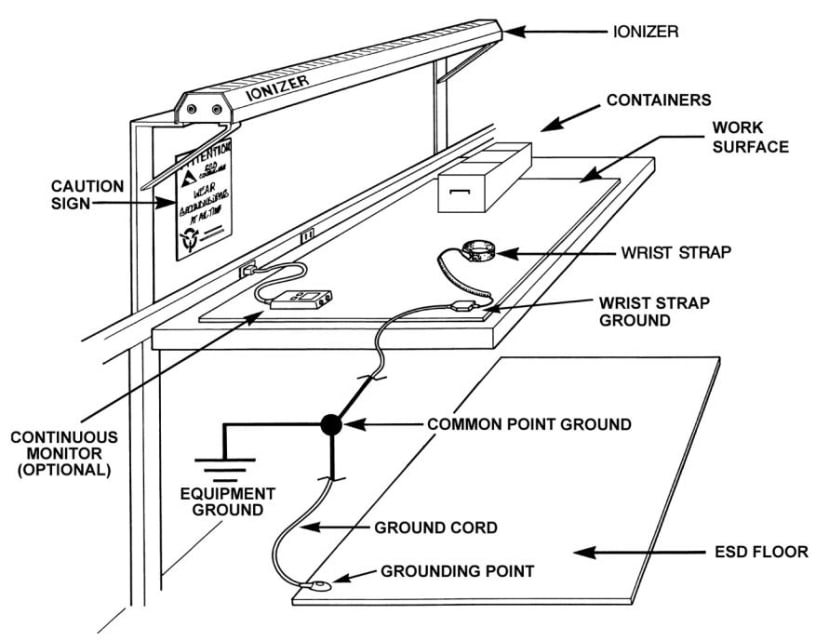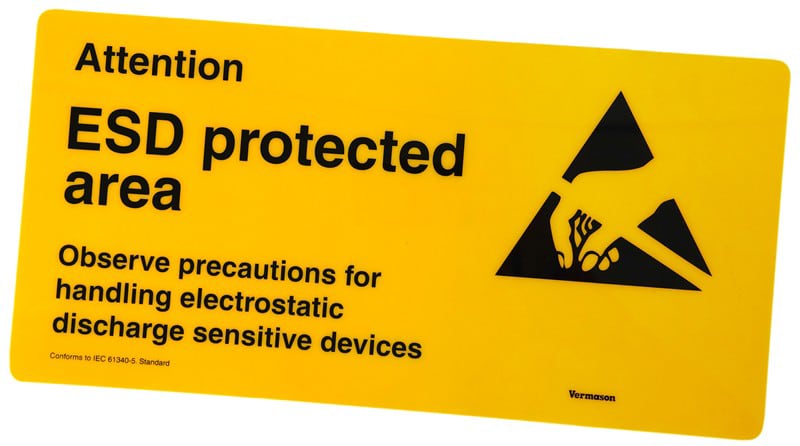What is an ESD Protected Area (EPA)?
Follow articleHow do you feel about this article? Help us to provide better content for you.
Thank you! Your feedback has been received.
There was a problem submitting your feedback, please try again later.
What do you think of this article?
We've mentioned the term "ESD Protected Area (EPA)" many times in previous blog posts but what exactly is it?
- Why do you need an EPA?
- How can you identify one?
- And most importantly what do you need to create an EPA?
This posts will help shed some light on these very common questions so let's go!
Definition of an ESD Protected Area (EPA)
An ESD Protected Area (EPA) is a defined space within which all surfaces, objects, people and ESD Sensitive Devices (ESDs) are kept at the same electrical potential. This is achieved by simply using only 'groundable' materials (i.e. materials with an electrical resistance typically of less than 109 ohms) for covering of surfaces and for the manufacture of containers and tools. All surfaces, products and people are bonded to Ground. Bonding means linking, usually through a resistance of between 1 and 10 megohms. Movable items (such as containers and tools) are bonded by virtue of standing on a bonded surface or being held by a bonded person. Everything that does not readily dissipate charge must be excluded from the EPA.
Example of an EPA
The user guide CLC/TR 61340-5-2:2008 defines an EPA as follows: “An ESD protected area (EPA) is an area that is equipped with the ESD control items required to minimize the chance of damaging ESD sensitive devices. In the broad sense, a protected area is capable of controlling static electricity on all items that enter that work area. Personnel and other conductive or dissipative items shall be electrically bonded together and connected to ground (or a common connection point when a ground is not available) to equalize electrical potential among the items. The size of an EPA can vary greatly. A protected area may be a permanent workstation within a room or an entire factory floor encompassing thousands of workstations. A protected area may also be a portable worksurface or mat used in a field service situation.” [CLC/TR 61340-5-2:2008 Use guide clause 4.6 Protected areas (EPA)]
An EPA could be just one workstation or it could be a room containing a number of different workstations.
>So to sum-up, in an EPA you:
- ground all conductors (including people),
- remove all insulators (or substituting with ESD protective versions) or
- neutralise process essential insulators with an ioniser.
Purpose of an ESD Protected Area (EPA)
Electrostatic Discharge [ESD] can damage components and products containing electronics. It is the hidden enemy in many high-tech factories. Often this damage cannot be detected by quality control inspections which can be very frustrating. ESD damage can adversely impact productivity, quality, product reliability and thus a company’s reputation and profitability. An EPA is an area that has been established to effectively control ESD and its purpose is therefore to avoid all problems resulting from ESD damage. Operators need to understand and follow the basics of ESD control to limit the generation of electrostatic charges, limit and slow discharges in the EPA.
Identifying an ESD Protected Area (EPA)
An EPA needs to be identified as such. You can use products such as floor marking tape and/or signs which are designed to attract attention and deliver a clear message to personnel and visitors, i.e. "You are entering an ESD Protected Area" or "You are leaving an ESD Protected Area".
Example of an EPA Warning sign
Creating an ESD Protected Area (EPA)
In its simplest form, an EPA area is a basic workstation and consists of the following components:
- an ESD working surface mat,
- a grounding cord,
- a wrist strap,
- a coiled cord and
- an Earth Bonding Point Plug (EBP Plug).
Set-up of a basic EPA
To create an EPA:
- Bond the operator to the EBP Plug using the wrist strap and coiled cord.
- Connect the ESD working surface mat to the EBP Plug using the grounding cord.
By following the above two steps, each element connected to the EBP Plug (the surface and the operator) are kept at the same electrical potential and any electrostatic discharge (ESD) is being removed to ground via the EBP Plug. The EBP Plug provides a common ground point for grounding using protective earth. The plug fits into the mains supply socket, making a connection with the earth conductor only. In place of the live and neutral pins are moulded insulating plastic pins to allow positive location in the socket. Do you have any questions for us? Let us know in the comments!



